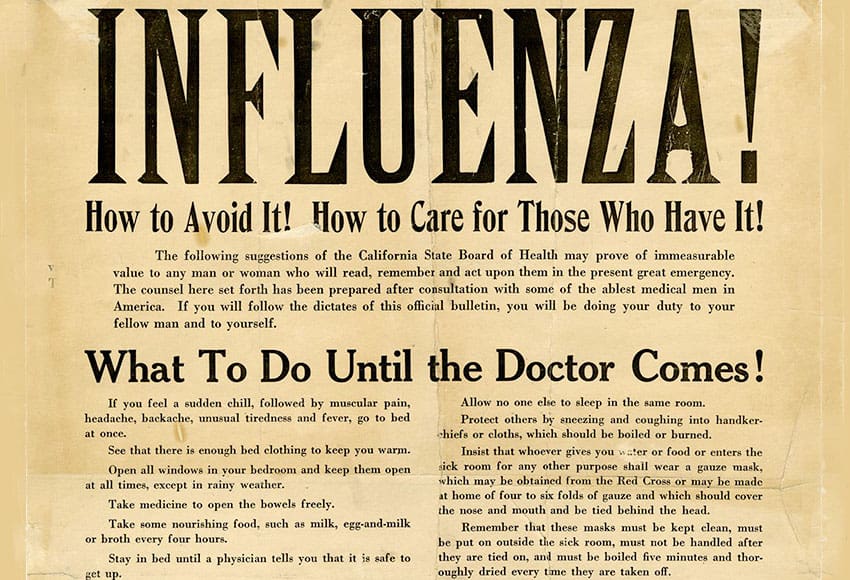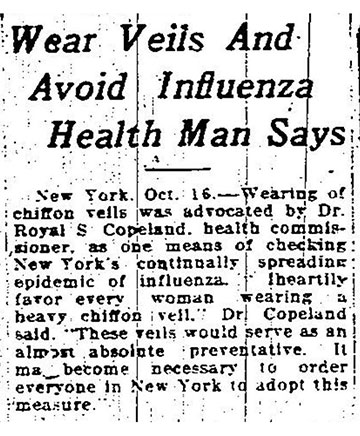Reflections on Current and Past Pandemics: A Historical Perspective

Andrew Helmus Distinguished Professor of History and Politics, Dr. John M. Theilmann, gives a historical perspective on the current pandemic by comparing it with two pandemics from the past: Europe’s Second Plague Pandemic and the 1918-19 H1N1 influenza virus outbreak.
Reflections on the COVID-19 Pandemic and Past Pandemics
by John M. Theilmann, April 9, 2020
COVID-19 has rapidly become a major health and economic problem worldwide. It is not the first disease to assume pandemic proportions. In this case 184 countries have reported cases with over 1,6000,00 confirmed cases and 94,000 deaths worldwide and over 450,000 confirmed cases in the United States with over 16,000 deaths.
This is a very serious medical problem especially, as various medical professionals indicate, there may be at least one or more waves of the disease later in the year and into next year. We clearly don’t know as much as we would like about the disease although we are gaining knowledge every day.
Another way to understand the impact of COVID-19 is to compare it with two pandemics from the past. The Second Plague Pandemic which hit Europe from the mid-fourteenth century to the early eighteenth century is the ultimate standard of comparison. The first outbreak of the disease, which occurred from 1347 to 1351, killed between 30% and 50% of the Europe’s population. In England, for example, the population declined from slightly over 5 million people to slightly more than 2.5 million. The plague reappeared in 1361, 1369 and on many occasions thereafter with some outbreaks causing a mortality rate of 10% or more. The societal disruption caused by the plague was substantial. The economies of many regions were negatively affected, social order declined in some areas, and some people turned to millenarianism as they sought relief. Some countries tried to prepare for the arrival of the disease. King Edward III of England ordered English ports to be closed before the plague reached England late in the summer of 1348. No one understood the bacterial cause of the disease and the medical response was unable to cope with the plague. The best advice anyone could offer was to flee, in essence, a form of social distancing. Society did not collapse during the Second Plague Pandemic, but it would be challenged at times.

The plague pandemic during the fourteenth century is the standard that all other pandemics are compared against because of its massive death toll. A more recent pandemic, the influenza pandemic of 1918-1919 also has lessons for us today especially as the disease directly affected the United States.
First, some numbers: Three waves of the disease, an initial one in the spring of 1918 that affected soldiers in several military camps preparing to go to France. A second wave that started late in the summer of 1918 and a third wave that lasted into the spring of 1919 both of which affected all of the U.S. The origin of the disease is still undetermined as it seemed to simultaneously appear in the U.S., Europe, and Asia. Who was infected? Usually, influenza affects the young and the elderly, essentially describing a ‘U’. This outbreak described a ‘W’ shape as the young and elderly were victims but so too were many people in their twenties and thirties. Over 500 million people were infected worldwide, one-third of the world’s population. How many people died? Between 50 and 100 million people worldwide and 675,000 people in the United States.
The numbers are staggering, but it must be remembered that our understanding of infectious disease was not as good in 1918 and the medical response was not as well-informed. In addition, the United States had just entered World War I and it and other countries were placing most of their attention on the war. The death toll in the United States would have likely been higher except that the U.S. was less of an urban nation than it is today.
Today we know that the causative agent of the 1918-19 outbreak was the H1N1 influenza virus.
Today we know that the causative agent of the 1918-19 outbreak was the H1N1 influenza virus, one that is atypical of most influenza viruses. The full genome has been synthesized using bodies that have been exhumed from the permafrost of Alaska and Norway. Initially many people responded to was becoming an influenza pandemic by saying, “Oh, it’s only the flu or the grippe” as influenza was still being called. Many cities tried to go on with business as usual with businesses remaining open, sporting events going on, and war bond parades being held. Philadelphia was one city that tried to carry on. However, shortly after a massive war bond rally early in the fall large numbers of people became ill. Many physicians and nurses were away from the city helping the war effort and the medical infrastructure was soon overwhelmed. At one point bodies were being stacked in the streets because they could not be buried. St. Louis, on the other hand, banned large public gatherings and suffering a lower death toll. Social distancing was practiced, but not uniformly. Theaters closed and some churches did not hold services. Bars and restaurants often continued to operate as usual. Sporting events were held. One famous photo shows a major league baseball player at bat during a game wearing a mask. War bond rallies and other patriotic events were held in many places.
Usually, influenza produces a mortality rate of 0.1%, but in this case, the mortality rate in the United States was 2.5%. Several factors contributed to this state of affairs. People often tried to go about their lives as usual and so readily spread the disease. The H1N1 virus affected a wider variety of people than other influenza viruses. It was also more lethal than many other variants of influenza. This flu virus also produced a large number of secondary pneumonia infections that killed people. There were no antibiotics to treat pneumonia in 1918. There were some impacts of the 1918-19 flu outbreak in the United States. In some cases, there were delays in sending troops to Europe. In some areas, businesses were negatively impacted.
The U.S. was more of rural nation than today and agriculture was not affected by the flu. The demands of the war effort kept businesses running. In addition, people had more of a tolerance for a large number of deaths from disease than today. From 1910 to 1916 more than 100,000 Americans, many in the South died from pellagra, with 1,306 dying in South Carolina alone in 1915. The influenza pandemic of 1918-19 quickly dropped from sight once it was over. People wanted to return to “normal” after the war in the 1920s. Besides, dying of the flu, unlike dying on a battlefield in France was not heroic and not worth mentioning. The novelist Katherine Anne Porter lost her army lieutenant fiancée to the flu. She was infected and ran such a high fever that her black hair fell out and when it grew back it was permanently white. In the mid-1920s she memorialized the outbreak in her short story “Pale Horse, Pale Rider.” The influenza pandemic would be largely forgotten until the 1970s where various people began to take an interest and address its biological and social importance.
Examination of past pandemics give us some cautionary points, but also a confidence that we will emerge from the COVID-19 pandemic.
As we confront COVID-19 we may take some comfort and learn some lessons from past pandemics. First, we will get through this and go on with our lives. Second, we are better prepared to cope with pandemic disease today than in the past, but it is still possible to overwhelm the medical infrastructure. Third, curing the disease is important, but preventing its onset even more so. Until a vaccine can be developed and administered, which will take some time in spite of the best efforts of the bio-medical community, the best preventative measure is to avoid contact, social distancing. Fourth, there will be economic disruptions given the nature of current economic life but we should use care to avoid furthering a more severe first peak of the disease as well as second and third waves, by ignoring social distancing precautions. Examination of past pandemics give us some cautionary points, but also a confidence that we will emerge from the COVID-19 pandemic.
Photo: Influenza! How to avoid it! How to care for those who have it! … What to do until the doctor comes! / Oakland Health Dept., Vault B-168, courtesy, California Historical Society, Vault_B-168.jpg.